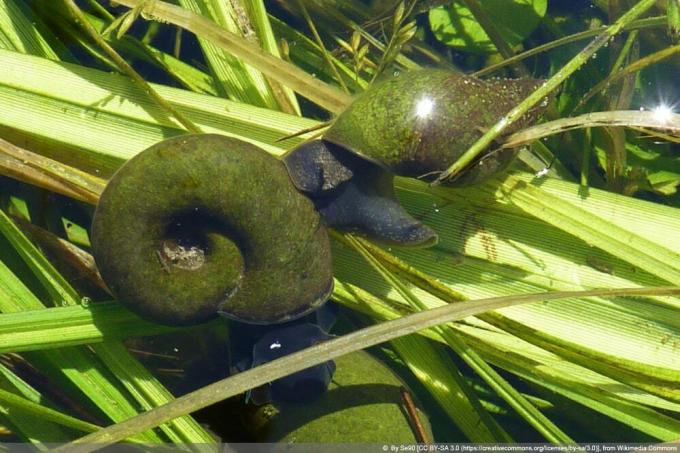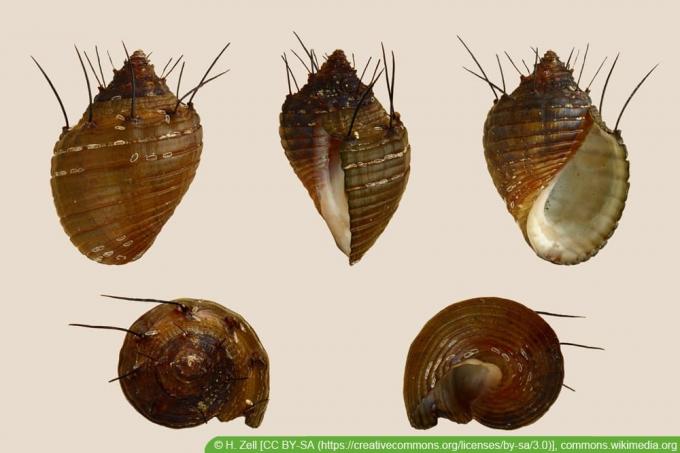

Table of contents
- General information
- attitude
- lining
- propagation
The ramshorn snail has the botanical name Planorbarius Corneus and is relatively easy to keep in the aquarium. The attractive little creatures can live for a few years and are peaceful companions who get along well with the other inhabitants of the aquarium. Due to its resilient characteristics, the ramshorn snail copes well with temperature fluctuations and similar changes in conditions.
General information
The ramshorn snail belongs to the family of the plate snails and is home to almost all tropical and temperate regions of the world. For this reason, it can adapt extremely well to the conditions in the home aquarium. Thanks to the peaceful characteristics of the animal, socialization with most inhabitants in the aquarium is possible without any problems. However, ramshorn snails are prey for puffer fish, crabs and some loaches, which is why the snails are gradually eaten up by them. Thanks to a very high level of oxygenation in the blood, the ramshorn snail rarely has to come to the surface of the water to breathe. In this way, the animals can also survive in extremely oxygen-poor waters. As a rule, the coloring of the snail shell is rather muted. However, there are also colorful variations in coloring that can be used to set beautiful color accents in the aquarium.
- Occurs in Europe, Asia and Africa
- Order of magnitude from 1.5 cm up to 4 cm
- Flat and disc-shaped case
- Has no tip but up to five turns
- Normally dark brown to reddish black base colour
- There are also pink and blue specimens
- Gets along well with fish, shrimp and other snails
- Suitable roommates are danios, guppies and tetras
- Grows up to 3-4 years old
It is the only snail to have hemoglobin in its blood, which causes its body to turn red. In case of strong excitement or distress, a drop of blood is secreted.
attitude
The ramshorn snail does not have a housing cover that could give it additional protection. This is why it often retreats extremely far into the housing and is then often no longer visible. For this reason, the aquarium should have natural planting and furnishings as welcome protection, otherwise the snail has no special requirements. Keeping it is therefore relatively easy and, given the right conditions, can be carried out without any problems. Although the ramshorn snail lives in its native waters as a cold water snail, it can adapt very well to warmer water conditions in the aquariums in living quarters. If the water is too soft and low in lime, the snails often gnaw on each other's shells. In this way, the animals try to compensate for the calcium deficit for the construction of their own housing.
- Ideal aquarium size from 30 liters volume
- Prefers tanks with a sandy to fine gravel bottom
- Plant the aquarium lushly
- Offer sufficient areas on stones
- Does not like too strong a current just above the bottom
- Tolerates temperatures of 10-25° C
- Optimal pH is 6.0-8.0
- The total hardness of the water should be between 10-30° dH
- Make sure there is enough lime in the water
lining

The ramshorn snails constantly graze the bottom of the aquarium for leftover food and are therefore welcome helpers when it comes to using up leftovers in the aquarium. In this way, the hard-working little animals help to prevent rotting spots. This leads to a sustainable improvement in water quality. However, if there is a lack of food, the snail will also eat parts of plants, including newly sprouting sprouts on the aquarium plants.
- Omnivore diet, belong to the omnivores
- Feeds on algae, detritus and uneaten food
- Prefers thin growth areas of algae
- Avoids filamentous and brush-like clumps of algae
- Protects the aquatic plants with sufficient food supply
Tip:
So that the ramshorn snail always has enough food, the cultivation of growth algae for the inner glass walls of the aquarium is a good idea. In this way, the animal always has enough opportunities to graze.
propagation
Ramshorn snails often come into the aquarium through newly purchased aquatic plants on which eggs have been laid beforehand. However, the cute little animals have a reputation for transmitting harmful diseases and the to eat plants that are already growing in the aquarium, which is why this snail species is often not fond of it seen. However, the owner of the aquarium should focus on their good qualities, since the ramshorn snail contributes an important part to a clean tank. The animal not only eats algae and dead plant parts, dead fish are also on the menu. In this way, the sensitive ecosystem in the aquarium is preserved in the long term by the snail. Therefore, it is always worth keeping and then propagating.
- Easy breeding and propagation
- Ramshorn snails are hermaphrodites
- Lay flat and disc-shaped spawning pads, with gelatinous attributes
- You need smooth and solid ground for this
- Hatching time depends on the water temperature
- After days or weeks, small young snails hatch
- These are already fully developed, but are still growing
Tip:
If the conditions are too good and there are no natural predators living in the aquarium, this can lead to explosive reproduction. Since this is undesirable in most cases and leads to a plague of snails, suitable countermeasures in the form of predators or collection are necessary.
 garden editorial
garden editorial I write about everything that interests me in my garden.
Learn more about pond animals

Marsh snail in the pond | 9 Posture Tips
Of the nearly 100,000 species of snails, only about 40 live in freshwater. The mud snail is one of the ten species that can also be found in a pond. It inhabits the bottom of the body of water and contributes significantly to cleaning it there.

Swimming pond with fish: This is how the combination works
A swimming pond with fish can be a very special highlight in the garden. However, the fish pose special challenges because the nutrient content of the water is significantly increased. However, the combination is possible with an appropriate structure and comprehensive filtering.

Tower snails | 13 tips for keeping & propagation
Tower snails are particularly popular aquatic animals in garden ponds - at least as long as they don't multiply endlessly. They also signal in aquaria whether optimal conditions exist. Tips for husbandry and propagation create an improved habitat without mass propagation.

Keeping pond mussels in the garden pond | 9 Posture Tips
The trend towards natural garden ponds has been unbroken for years. Many garden owners use it to create their own small wet biotope. However, this is not possible without appropriate stocking with plants, small fish and pond mussels.

Dragonfly larvae in the pond: what do dragonflies eat?
Anyone who finds dragonfly larvae in the pond can be happy. Because the insects are useful predators and can, for example, reduce the number of mosquitoes. However, they do not feed exclusively on animals that can cause harm. Here's what dragonflies eat.

Keeping Sunfish in the Pond | 7 tips on husbandry & feed
Perch are predatory fish and therefore rather unsuitable for pond keeping. An exception, however, is the magnificent bluegill, which usually gets along well with other fish. Here is what you need to pay attention to when keeping it.

